IV. SOILS AND HOMESITES
Homesites with Onsite Disposal Systems Next Section>>
More than 25 million homes, encompassing almost 25 percent of the U.S. population, dispose of domestic wastewater through onsite systems rather than a municipal sewer system. According to the American Housing Survey for the United States, in 1993, three out of every eight new homes used onsite wastewater disposal.
In Indiana, more than one-third of the people use onsite wastewater disposal, and 15,000 new onsite permits are granted every year. According to a recent survey of county sanitarians, a large percentage of homes in the country and small towns do not have any onsite wastewater disposal system or the existing system has failed. For those with no system, sewage is discharged directly to the land surface, ditches, or streams.
One of the major differences between owning an unsewered versus a sewered home is that unsewered wastewater treatment and disposal systems must be maintained by the homeowner. Treatment and disposal of wastewater should be one of the primary concerns of any homeowner in an unsewered area.
The most common way to treat and dispose of wastewater in rural homes is through the use of an onsite disposal system. The majority of onsite disposal systems in the United States are septic systems.
Using soil to purify household wastewater provides the opportunity to teach students about several physical, chemical, and biological soil processes. These processes are greatly affected by the soil properties that soil evaluation students determine in the field, so they have the opportunity to observe real examples of what they study in the classroom. It is likely that the houses many students now live in, or will live in, depend on onsite wastewater systems. This manual should help them gain a better understanding of how these systems work, how they relate to soil properties, and how to care for them. This understanding should, in turn, lead to fewer failures and more efficient operation of home wastewater disposal systems.
back to topWater Quality and Wastewater Disposal
We expect our drinking water to be pure, and we also expect that getting rid of our wastewater will not cause us any inconvenience. This section explains the hydrologic cycle and describes the contaminants in wastewater that must be gotten rid of before we again drink the water. It sets the stage for a description of wastewater treatment systems.
back to topGroundwater
Water in the saturated zone beneath the soil surface is commonly referred to as groundwater. Groundwater is but one stage, or form, through which water passes in the earth’s hydrologic cycle (Fig. 30). The hydrologic cycle is the continual movement of water over, in, and through the earth and its atmosphere as it changes from one form—solid, liquid, or vapor—to another.
The water you use today may have evaporated from an ocean, traveled through the atmosphere, fallen back to the Earth’s surface, gone underground, and flowed through streams leading back to the oceans. Water is readily visible in many forms, including clouds, rain, snow, fog, lakes, streams, oceans, and polar ice caps. Groundwater, although not visible because it is located beneath the soil surface, is a vital resource for the success and survival of the entire ecosystem.
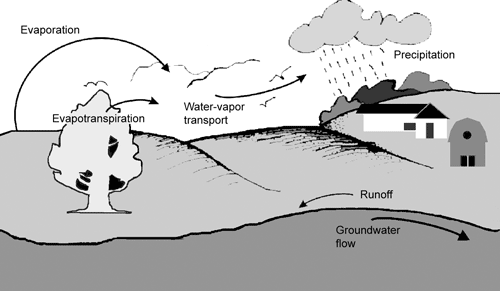
Fig 30. Hydrologic cycle.
Groundwater has been tapped for thousands of years, but only recently have we started to understand its importance and how to manage this precious resource. Much remains to be discovered about groundwater, and wider public awareness of its nature and properties is an important first step.
The process by which water—from rainfall, snowmelt, and other sources—flows into a water-bearing geologic formation (aquifer) is known as recharge. Water first passes through the unsaturated zone, where soil pores are filled partly with air and partly with water (Fig. 31). The water then flows downward through the unsaturated zone into the saturated zone, where the soil pores are completely filled with water. The boundary between these two zones is called the water table. The water table rises when water enters the saturated zone and falls when water is discharged from the saturated zone either naturally (e.g., springs, lakes, or rivers) or by pumping (e.g., wells).
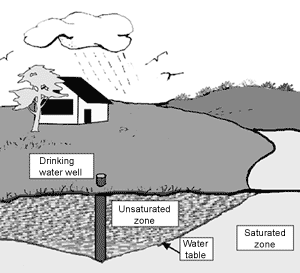
Fig 31. Water table and unsaturated zone.
The unsaturated zone is important to the groundwater underlying it. As incoming water seeps down through the unsaturated zone, impurities are removed, helping to cleanse the water. Both the quantity and quality of groundwater are affected by the condition of the unsaturated zone in a recharge area. Home wastewater disposal systems affect both.
back to topSurface water
Surface water is any water body on the earth’s surface, such as lakes, rivers, and creeks. It also includes water in drainage ditches and water that seeps from a hillside. Surface water is the source of drinking water for many cities. It is also used for swimming, boating, and fishing. Pollution of surface water can lead to illness of people who drink it or come in contact with it. Surface water is treated before it becomes drinking water, but occasionally pathogenic organisms get through the treatment process. Surface water can be polluted by failed wastewater disposal systems. If a disposal system fails, partially treated wastewater may seep out at the soil surface, where people may come into contact with it, or it may get into tile drains that flow into drainage ditches and then creeks, rivers, reservoirs, and lakes.
back to topWastewater
Wastewater is mostly water by weight. Other materials make up only a small portion of wastewater but can be present in large enough quantities to endanger public health and the environment. The wastewater components that should be of most concern to homeowners and communities are those that have the potential to cause disease or detrimental environmental effects.
Solids
Solid materials in wastewater consist of both organic and inorganic materials. They are significantly reduced by treatment in a septic tank and in the soil. In a septic tank many of the solids settle to the bottom and are digested, but some solid material stays in suspension.
Organisms
Many different types of organisms live in wastewater, and some are essential contributors to treating it. A variety of bacteria, protozoa, and worms break down certain carbon-based (organic) pollutants in wastewater by consuming them. Through this process, organisms turn organic wastes into carbon dioxide and water, but the organisms themselves contribute to organic wastes. Bacteria and other microorganisms are very plentiful in wastewater and carry out most of the treatment. The success of wastewater treatment systems relies in large part on biological processes of organisms.
Pathogens
Many disease-causing viruses, parasites, and bacteria are also present in wastewater. They originate from people and animals that are infected with or are carriers of a disease. Some illnesses from wastewater-related sources are relatively common. Gastroenteritis can result from a variety of pathogens in wastewater, and cases of illnesses caused by the parasitic protozoa Giardia lambia and Cryptosporidium are not unusual in the U.S. Other important wastewater-related diseases include hepatitis A, typhoid, polio, cholera, and dysentery. Outbreaks of these diseases can occur as a result of drinking water polluted by wastewater, eating contaminated fish, or swimming or wading in polluted waters. Animals and insects that come in contact with wastewater can spread some illnesses.
Organic matter
Organic materials are found everywhere in the environment. They are the building blocks of all living things. Organic materials in wastewater originate from human wastes, paper products, detergents, cosmetics, foods, and other sources.
Organic compounds are a combination of carbon, hydrogen, oxygen, nitrogen, and other elements. Organics such as proteins, carbohydrates, and fats are biodegradable, which means they can be consumed and broken down by organisms. However, even biodegradable materials can cause pollution. In fact, too much organic matter in wastewater can be devastating to receiving waters.
Large amounts of biodegradable materials are dangerous to lakes, streams, and oceans, because organisms use dissolved oxygen in the water to break down the wastes. This can reduce or deplete the supply of oxygen in the water needed by aquatic life, resulting in fish kills, odors, and overall degradation of water quality. The amount of oxygen organisms need to break down wastes in wastewater is referred to as the biochemical oxygen demand (BOD) and is one of the measurements used to assess overall wastewater strength.
Some organic compounds are more stable than others and cannot be quickly broken down by organisms, posing an additional challenge for treatment. This is true for many synthetic organic compounds developed for agriculture and industry. In addition, certain synthetic organics are highly toxic. Many pesticides and herbicides are toxic to humans, fish, and aquatic plants. Often they are disposed of improperly in drains. In receiving waters, they kill or contaminate fish, making them unfit to eat. New synthetic organic compounds are being developed all the time, which complicate treatment efforts.
Oil and grease
Fatty organic materials from animals, vegetables, and petroleum are not quickly broken down by bacteria and can cause pollution in receiving environments. When large amounts of oils and greases are discharged to receiving waters from community systems, they increase BOD and they may float to the surface and harden, causing aesthetically unpleasing conditions. They also often trap trash, plants and other materials, causing foul odors, attracting flies and mosquitoes and other disease-carrying organisms. In some cases, too much oil and grease causes anaerobic conditions in ponds and lakes by preventing oxygen from the atmosphere from entering the water.
Too much oil and grease dumped down drains can clog effluent distribution lines and soil absorption fields, causing system failure. Excessive grease also adds to the septic tank scum layer, causing more frequent tank pumping to be required. Both possibilities can result in significant costs to homeowners.
Nutrients
Wastewater contains large amounts of nitrogen (N) and phosphorus (P), which promote plant growth. Organisms responsible for biological treatment of wastewater require only small amounts of these nutrients, so there is a large excess of nutrients in wastewater. Ordinary home waste disposal systems get rid of very little N and P, so most of what leaves a house passes through the system and into the soil and water. If water bodies become very rich in nutrients, algae grow vigorously and the water becomes depleted of oxygen. This condition is called eutrophication. Deprived of oxygen, fish and other aquatic life die, emitting foul odors. Iron (Fe) is an important plant and animal nutrient and is an important component of wastewater in much of Indiana. The chemistry of N, P, and Fe, and the eutrophication process are described in the section, Soil and Water Chemistry. It should be of interest to those who have studied chemistry or environmental science.
back to topPlanning and Installing a Disposal System
A typical wastewater disposal system contains two major components, a septic tank and a soil absorption field (Fig. 32). In some cases, a secondary treatment unit is installed between these two components. A properly installed and maintained home wastewater disposal system poses no threat to groundwater or surface water. However, inadequately functioning and/or failing septic systems can contribute to the contamination of both. Wastewater from septic systems may include many types of contaminants, such as nitrates, harmful bacteria, and viruses.
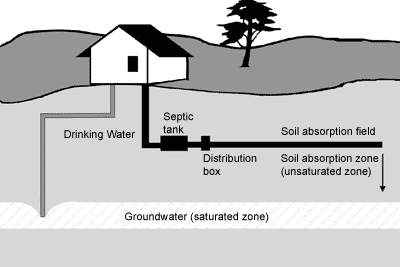
Fig 32. Conventional onsite wastewater disposal system.
Trace amounts of metals may be contributed to the system from persons using some medications. Also, commonly used chemical substances, such as pesticides, paints, varnishes, and thinners, can contaminate the groundwater if they are not disposed of properly. Some chemicals, even in small amounts, can be dangerous to both the environment and public health.
Through physical, chemical, and biological processes, the soil acts as a natural filter to remove bacteria and viruses in the unsaturated zone. However, some soil conditions, such as high water tables, very slowly permeable horizons, or very rapidly permeable horizons can allow these bacteria and viruses to be transported very rapidly to the groundwater where they can contaminate drinking water supplies.
It is critical that your drinking water well is properly sited, has a sealed casing, and is located the required distances away from septic systems, both yours and your neighbor’s. This will help prevent contaminants from seeping into and mixing with drinking water (Fig. 33).
Separation distances
A septic system must be located a certain distance away from drinking water wells, streams, lakes, houses, and water supply lines. These distances are referred to as horizontal separation distances. Minimum horizontal separation distances required in Indiana are shown in Fig. 34. Vertical separation distances depend on soil properties, and will be discussed in the next section.
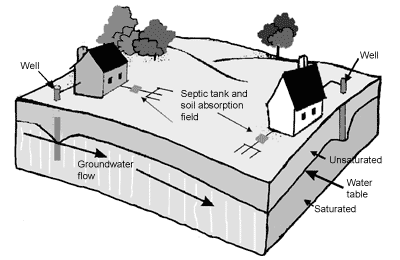
Fig 33. Correct location of a soil absorption field and
drinking water wells.
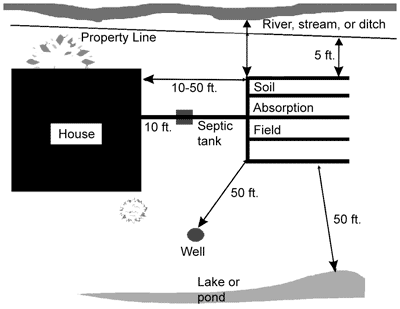
Fig 34. Minimum horizontal separation distances in Indiana. The distance between the house and the soil absorption field is smaller if the field is downslope from the house and vice versa.
Determining system size and water usage
Water use in rural households is often predicted from the number of bedrooms in the house. Although the actual number of residents determines water use, the house plan determines the potential number of residents (e.g., number of bedrooms), water usage, and subsequent wastewater flow.
Actual wastewater flow rates range from 40 to 120 gallons per person per day. Typical minimum septic tank sizes range from 1,000 to 1,500 gallons. The flow estimate, plus the soil permeability estimate (i.e., how easily water moves through the soil), is used to determine the area of the absorption field needed for the system. Installing an absorption field of sufficient size is critical to the proper functioning of your septic system. State and local regulations should always be reviewed before installing a septic system.
back to topSite evaluation and installation
Onsite wastewater disposal systems should effectively treat wastewater for many years if they are:
• installed in suitable soils,
• designed for specific soil conditions,
• carefully constructed when soil is not too wet, and
• faithfully maintained.
Any weak link in this chain could result in failure of the system.
Not all soils are suitable for onsite wastewater disposal systems, and some soils on a property are more suitable than others. Potential homeowners must obtain a permit from the county health department before they can install a disposal system. To get this permit, they must first have an evaluation of the soils. The evaluation should be done by an experienced soil scientist. He or she will examine the soils on the homesite, determine if they are suitable for a soil absorption field, and indicate those that are most suitable. Soil evaluation students also examine soils and evaluate their suitability, but in a less detailed manner.
The absorption site must be in natural soil, not fill, because the permeability of fill is often very slow because it was compacted during the filling operation. The permeability of natural soil can also be greatly reduced by driving heavy equipment on it. To prevent compaction, the proposed site should be fenced off before construction begins so it will not be disturbed. Also, onsite wastewater disposal systems should not be installed when the soils are wet because wet soils are easily compacted and smeared.
back to topCaution
This chapter describes practices that have been used successfully in some states. They have not all been approved for regular use in Indiana, however. In Indiana, county health departments grant permits for conventional wastewater disposal systems for single family residences, and the State Department of Health grants permits for larger systems and for innovative systems. Make sure to check with these agencies before planning or installing any wastewater disposal system. Have soil evaluations done by certified professionals. Also, use qualified contractors who have had experience installing systems locally, and contract with maintenance firms with good recommendations.
back to topSeptic Tanks
The septic tank is usually made of concrete or plastic and must be watertight. All septic tanks have baffles at the inlet and outlet to insure proper flow patterns. Previously, most septic tanks were single compartment, but two-compartment tanks (Fig. 35) or two single compartment tanks in series are becoming more common. Plastic effluent filters, located at the outlet, are not required in Indiana, but are highly recommended.
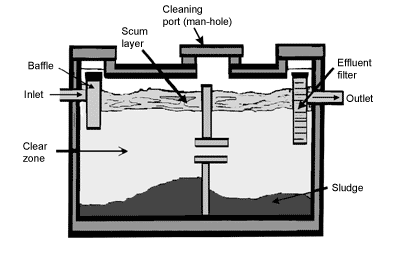
Fig 35. Two compartment septic tank.
While typically designed to hold a minimum of 1,000 gallons of wastewater, the size of the tank may vary depending upon the number of bedrooms in the home and regulatory requirements. The primary purpose of the septic tank is to separate the solids from the liquids and to promote breakdown of organic contaminants by microorganisms naturally present in the wastewater.
Bacteria that do not use oxygen from the air grow in the tank. These bacteria are called anaerobic and the by-products of their activity are methane and hydrogen sulfide gas, plus other substances having odor. Hence the word “septic,” which means decaying or rotting, has been applied to this tank. But the septic tank might also be described as a settling tank where wastewater solids are stored while the bacteria decompose them. The bacteria never completely decompose the solids, however, so a residue remains. This residue must be cleaned out of the tank when the volume becomes too great.
There are three distinct zones or layers in the tank (Fig. 35). At the
top is the floating scum layer that collects wastes such as soap or detergent
scum, cooking fats, cigarette filters and any other material that floats.
Bacteria in the tank decompose little of this scum. At the bottom of the
tank is the sludge layer that consists of decomposing and partially decomposed
solids that settle out. The center zone, called the clear zone, is liquid
that contains suspended solids and bacteria. This liquid is called effluent
as it leaves the tank. Some solids can’t
make up their minds whether they will sink or float and remain in the clear
zone between the scum and sludge layers until they are carried out through
the outlet. As the scum and sludge layers become thicker, the depth of the
clear zone decreases and wastewater passes through the tank faster. This leaves
less time for decomposition, and more solids are carried out of the tank into
the soil absorption field. The tank needs to be pumped out whenever the scum
layer at the top of the tank or the sludge layer at the bottom gets too thick.
More solids remain in the effluent as the septic tank becomes less efficient,
but even if the septic tank is working at top efficiency, the effluent contains
suspended and dissolved material. These contaminants must be removed from the
water in the soil absorption field.
Solids that are allowed to pass from the septic tank can clog the pores in the soil of the absorption field. Keeping solids out of the absorption field not only prevents clogging, but also reduces potentially expensive repair or replacement costs and helps extend the time that a soil can effectively treat septic tank effluent. An effective safeguard in keeping solids out of the absorption field is the use of effluent filters on the outlet of the septic tank. When these filters plug, they can be hosed off when the tank is pumped. This is an inexpensive but effective way to protect the expensive soil absorption field.
Table 7 shows the effectiveness of septic tanks in purifying wastewater. The rows in this table list different kinds of contaminants in the water. There are many solids in untreated wastewater. They settle to the bottom of the septic tank where they are digested by microorganisms and mostly converted to suspended solids, dissolved materials, and gases. Some solids, however, remain in the bottom of the tank until they are pumped. Suspended solids remain in the clear zone in the septic tank until they leave with the effluent. In the laboratory they are determined by weighing the solids that are retained on a 2-micrometer filter. Biochemical oxygen demand, BOD, is an index of the dissolved and suspended organic matter in wastewater and effluent. Actually, the BOD test measures the amount of dissolved oxygen that organisms are likely to need to degrade wastes in wastewater. This test is important for evaluating both how much treatment the wastewater is likely to require and the potential impact it can have on groundwater and surface water. BOD5 is a measure of the oxygen consumed in five days. Septic tank effluent is high in suspended solids and BOD (Table 7), and these materials must be removed from the water by the soil, sometimes aided by secondary treatment. The total nitrogen content of wastewater is reduced very little in a septic tank.
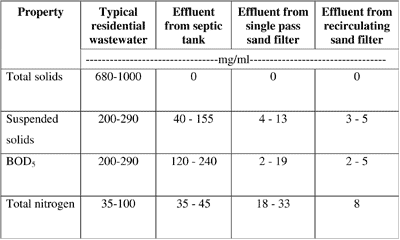
Table 7. Quality of residential wastewater and effluent from a septic tank and sand filter.
back to topSoil absorption fields
Septic tanks remove many of the solid wastes from wastewater, but septic tank effluent still contains many potentially disease-causing microorganisms and pollutants that must be removed by the soil. This section explains how soil absorption fields work. It also discusses how soil properties determine which kind of absorption field is best suited to a particular site.
Soil processes
In the soil absorption field, effluent flows from the septic tank into a distribution box that separates the effluent evenly into a set of distribution lines which consist of perforated pipes or tubes surrounded by aggregate, such as gravel or crushed rock. (Note that the term “aggregate” used in this context has a different meaning than when the word was used earlier to describe a cluster of small soil particles.) Depending on the depth of the water table or limiting layer, the distribution lines may be installed in trenches below the original soil surface, in ridges just above the surface, or in a bed of sand placed above the original soil surface. The effluent is distributed through the perforated pipes, exits through the holes in the pipes, and trickles through the aggregate where it is stored until it is absorbed by the soil. The absorption field, which is located in the unsaturated zone of the soil, treats the wastewater through physical, chemical, and biological processes. The soil also acts as a natural buffer to filter out many of the harmful bacteria, viruses, and excessive nutrients, effectively treating the wastewater as it passes through the unsaturated zone before it reaches the groundwater (Fig. 32).
Wastewater contains nutrients, such as nitrates and phosphates, that in excessive amounts may pollute nearby waterways and groundwater supplies. Excessive nutrients in drinking water supplies can be harmful to human health and can degrade lakes and streams by enhancing weed growth and algal blooms. The soil can retain many of these nutrients, which are eventually taken up by nearby vegetation, especially if the disposal pipes are near the surface.
The septic tank is anaerobic, meaning that it operates without oxygen. To successfully treat effluent, however, soils must be aerobic, meaning that they have access to atmospheric oxygen. Soils must do the rest of the purification, and they do this by several processes.
• Soils physically filter out some of the larger particles in septic tank effluent.
• Microorganisms do most of the purification in soils. A different set of bacteria lives in the aerobic soil than in the anaerobic septic tank. These aerobic bacteria break organic compounds in the effluent down mainly to carbon dioxide and water. They also kill and consume many of the harmful bacteria.
• Soil clays have negative charges that attract and hold dissolved cations in the septic tank effluent such as sodium (Na+), calcium (Ca2+), and potassium (K+).
• Some soluble components of the effluent are absorbed on soil particles by other processes. Dissolved phosphate, for example, can be chemically absorbed by iron oxide minerals in the soil.
• Some soluble materials, such as reduced iron and manganese, oxidize and precipitate out when they reach the aerated soil.
Biomat formation
Some purification processes result in plugging of soil pores, so the soil becomes more and more impermeable the longer the absorption field is in place. Often, a biomat forms at the interface between the aggregate and the natural soil. This mat consists of both organic and inorganic material. Much of it is a by-product of microbial growth. A poorly functioning septic tank hastens the development of a biomat because the effluent contains a higher than normal concentration of organic matter which feeds microorganisms so they can produce more biomat material. In some cases, plugging of soil pores, formation of a biomat, or both become so great that effluent can not move through the mat and into the soil. This causes effluent to fill up the trench and eventually pond on the soil surface causing a health hazard.
back to topSoil properties
For the treatment processes to operate successfully, the soil must absorb and transmit the effluent at a moderate rate. If the rate is too slow, the soil will not accept the effluent at the rate the home produces it. If the rate is too fast, the effluent moves through the soil before the microbes can purify it. In soil evaluation, the soil horizons that transmit water too fast or too slowly are called limiting layers. Fragipans, dense till, and bedrock transmit water too slowly, while coarse sand and gravel transmit it too quickly. In Indiana, there must be at least 20 to 30 inches of moderately permeable, well aerated soil between the bottom of the soil absorption trench and the top of a limiting layer. Soil horizons that have an intermediate permeability and are not too wet are suitable for processing effluent. The size of the absorption field always depends on the permeability of the soil.
Many soils in Indiana are poorly or somewhat poorly drained. The water table in these soils rises nearly to the surface of the soil in the winter and early spring. Occasionally water ponds on the soil surface. The water table falls in late spring and summer when the weather gets warm, evaporation increases, and plants pump water out of the soil. When the water table is low, most or many of the soil pores are filled with air, oxygen moves through the soil easily, and aerobic microorganisms flourish. When the water table is high, however, all of the pores are filled with water, so oxygen cannot move through them, and anaerobic microorganisms flourish. The anaerobic bacteria cannot complete the purification process that started in the septic tank. The seasonal high position of the water table is indicated by the natural drainage class. For a soil to purify sewage effluent aerobically, there always must be an unsaturated zone between the bottom of the absorption trench or bed and the water table when it is at its seasonal high. In Indiana, this zone must be 20 to 24 inches thick.
In summary, to maintain aerobic conditions and remove contaminants effectively, the absorption field must be adequately separated from the seasonally high water table and from limiting layers. This is known as the vertical separation distance. In Indiana the bottom of a soil absorption trench must be at least 20 to 24 inches above the seasonally high water table and at least 20 to 30 inches above a limiting layer. Specific distances are listed in Table 8. Soil evaluators estimate the depth of the seasonally high water table from soil drainage classes and also determine if the upper boundary of a limiting layer is 0 to 20 inches, 21 to 40 inches, or more than 40 inches deep. They use this information to determine the kinds of absorption fields that are suitable for a certain site, as explained in more detail later. The permeability of the soil below the effluent lines determines the size of the soil absorption field. This is reflected in the soil evaluation rules for trench systems.
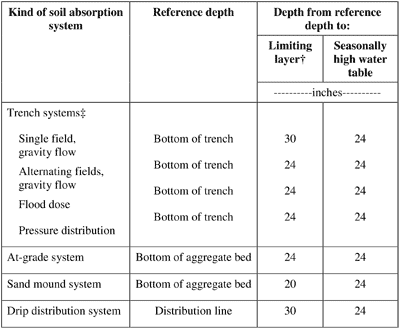
Table 8. Minimum vertical separation distances for various kinds of soil absorption fields in Indiana.
Kinds of Soil Absorption Fields and Effluent ApplicationEffluent from the septic tank is usually distributed to a soil absorption field through perforated pipes surrounded by aggregate, called effluent distribution lines. Soil absorption fields differ in 1) number of soil absorption fields, 2) vertical placement of distribution lines (below, at, or above the original soil surface), 3) material through which effluent is distributed in trenches, 4) timing of effluent application and pressure in effluent lines, and 5) supplemental drainage near the soil absorption field. The options can be combined in different combinations to produce several kinds of soil absorption systems. A few of these are listed in Table 8.
Number of soil absorption fields
Usually one field is installed, but with alternating fields, two fields are constructed, and effluent is diverted to one for 6 to 12 months, and then to the other. A field may lose some of its absorption capacity when it is in use, but can recover when it is not used. During the resting period the biomat at the trench/soil surface may dry out and shrink away from the surface or soil organisms may consume some of the biomat. Also, if one field fails, effluent can be diverted to the other one so toilets, showers, and other plumbing fixtures can still be used while repairs are made.
Vertical placement
Distribution lines are usually placed in subsoil trenches (Fig. 36, bottom),
but they may be placed near the original soil surface (Fig. 36, center),
or in mounds built on top of the original soil (Fig. 36, top). These figures
show cross sections through one distribution line. In practice, however,
several parallel lines are installed. In all cases there must be at least
20 to 30 inches of well aerated, moderately permeable soil material between
the distribution line or trench bottom and any limiting condition (high
water table or limiting layer). Specific vertical separation distances
are listed in Table 8.
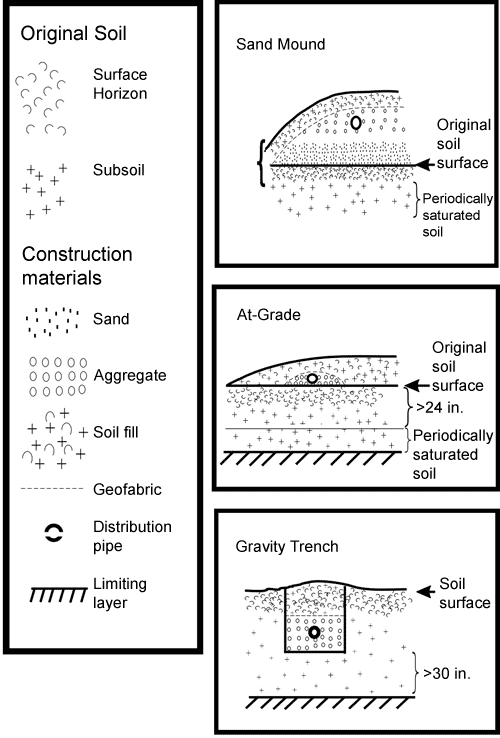
Figure 36. Cross sections through one line of a soil absorption field in a sand mound, at-grade system, and gravity trench. A soil absorption field usually has several parallel lines (Figure 34).
Gravity flow trench system is the most common kind of soil absorption field. Effluent flows by gravity, without pumps, to the field when the wastewater level in the septic tank rises above the outlet pipe. The distribution tubes or pipes in the trench are surrounded by aggregate, usually gravel (Fig. 36). A heavy plastic fabric, called geofabric, is laid on top of the aggregate, and then the trench is filled with soil material. Effluent trickles over the gravel where microorganisms can digest dissolved and suspended organic materials. Fig. 37 shows a side view of a septic tank and gravity flow trench system. The bottom of the aggregate bed must be at least 30 inches above a limiting layer and at least 24 inches above a seasonally high water table (Table 8). The size of the system depends on the permeability of the soil in which it is installed. Generally, finer textured soils have slower permeability than coarser textured soils. Note that the soil evaluation rules for the two kinds of trench systems are similar except for subsoil texture.
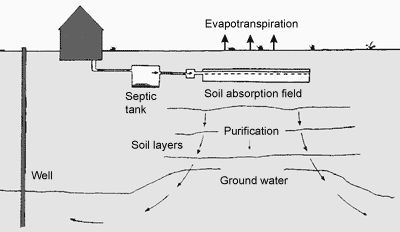
Fig 37. Side view of the components of a septic tank and trench soil absorption system.
At-grade system. If the soil has a limiting condition within 24 inches of the surface, effluent distribution lines cannot be placed in the subsoil but they can be placed slightly above the soil surface or “at-grade” (Table 8). Before installing an at-grade system, the soil must be protected against compaction or anything else that will harm its ability to absorb water. Effluent tubes are placed on top of a linear bed of aggregate on the soil surface, the lines are covered with more aggregate to from long ridges and then the ridges are covered with geofabric and soil fill (Fig. 36). Generally a dose tank follows the septic tank, and effluent is periodically pumped from the dose tank to the distribution lines. At-grade systems should not be used where the slope is more than 6% because effluent might seep out to the surface on steeper slopes. For soil evaluation, the 20 inch depth to a limiting layer is closest to 24 inches mentioned above and is used in the rules.
Sand mound system. If the limiting soil condition is even closer to the surface, distribution lines must be still higher. In an elevated sand mound system, a layer of sand is placed on the soil surface, which has not been disturbed. The sand is washed and must meet certain sand size requirements. Distribution tubes are placed in an aggregate bed on top of the sand, and the aggregate and tubes are covered with geofabric and soil fill (Fig. 36). The aggregate bed must be at least 20 inches above a limiting layer or a seasonally high water table (Table 8). As in the at-grade system, effluent is pumped into the mound system. The components of a sand mound system are illustrated in Fig. 38. Mound systems should not be used on soils that have a slope of more than 6% because effluent might seep out and pond around the base of the mound.
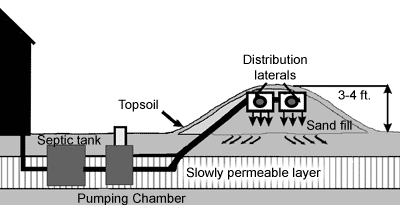
Fig 38. Arrangement of the components of a sand mound soil absorption system.
Drip distribution system. Effluent is distributed through small diameter tubes placed in slots cut into surface soil horizons. Effluent drips, or is injected under pressure, from ports regularly spaced along the tube into the biologically active zone of the soil. In this way, effluent provides water and nutrients to lawns, natural areas, or crops. The topsoil and plant root system provides an excellent environment for treating effluent. Compared with gravity flow trench and at-grade systems, in the drip system:
• The distribution lines are much smaller in diameter (Fig. 39) and much longer (Fig. 40).
• The interface area between the trench or slot and the soil is much greater.
• The amount of biomat formation is likely to be less because the rate of flow across this interface is smaller.
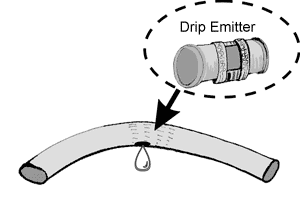
Fig 39. Detail of one drip emitter in a plastic line of a drip distribution system.
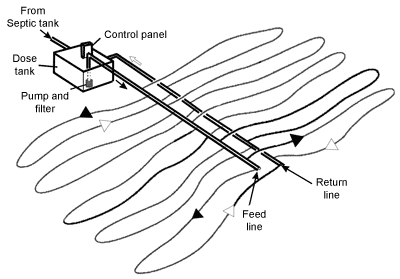
Fig 40. Design of lines in a typical drip distribution system.
• Nutrients are added in the rooting zone of the original soil, so chemical fertilizer application to lawns can be reduced.
• Pumps are required; they are not needed in gravity flow trenches.
• Freezing in the absorption zone may be a problem.
Most drip systems require secondary treatment, such as a sand filter. If, however, effluent is distributed directly from a septic tank, a filter should be used to remove particles that could plug up the small distribution lines. The size of the system depends on the rate the soil accepts effluent, similar to a gravity flow trench system.
The distribution lines are near the soil surface in both the drip distribution and the at-grade systems. The soil evaluation rules below are somewhat less restrictive for drip distribution than for at-grade because the larger area covered by distribution lines in the drip distribution system should compensate for somewhat less vertical separation between the distribution line and the limiting condition (limiting layer or wetness features). Freezing in the soil absorption zone is a potential problem, but the systems have been used in colder climates, such as those in Minnesota, Wisconsin, and Michigan, so apparently it is not a great problem. Because the systems are new in Indiana, State Department of Health rules require that the distribution lines be 30 inches above a limiting layer and 24 inches above wetness features. (Table 8). Exceptions might be made for favorable site conditions, however. Make sure to check with the county health department before planning any system, especially a drip distribution system.
Distribution material in the trench
Aggregate, gravel or crushed rock material, about 0.5 to 2.5 inches in diameter, is generally used to distribute effluent. In Indiana it is mainly gravel from outwash or crushed limestone.
Leaching chambers may replace aggregate in a trench. A chamber is an open-bottom, arch-shaped, plastic structure about 2 to 3 feet wide, 6 to 9 feet long, and 1 to 1.5 feet high (Fig. 41). Several chambers are joined end-to-end to fit into a standard three foot wide trench. After they are laid in the trench they are covered with soil material. Effluent flows from a distribution line onto the bare trench bottom where it is absorbed.
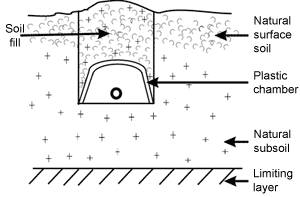
Fig 41. Cross section through one trench of a soil apsorption field with a plastic chamber for distributing effluent.
Timing of application and pressure in effluent distribution lines
Gravity flow is the usual method as described for the gravity flow trench. Effluent flows slowly by gravity to all lines of the absorption field when sewage enters a full septic tank. Effluent probably saturates the first part of a trench, but may never reach the end of it.
Flood dose (low pressure dosing). In this system, effluent flows from the septic tank into a dose tank, is pumped into the distribution box, and then flows to the soil absorption field. Flood dose can be used in mounds, at-grade systems, and trench systems where the distribution lines are higher than the septic tank. It might have an advantage over gravity flow because a large dose of effluent will fill all trenches more evenly and more of the trench will be used for absorption.
Pressure systems. This system is similar to the flood dose system except that effluent is pumped to the effluent distribution lines under pressure, which provides more uniform distribution to each line. It is used in most at-grade, mound, and drip irrigation systems.
Supplemental drainage
Diversion structures divert surface flow from upslope away from the homesite and soil absorption field. Diversion drains do the same for water that seeps through the subsoil. Without these practices, much of the upslope water would seep into the soil absorption field, which could cause it to fail. Diversion structures and drains are one of the homesite practices described previously (Fig. 29).
Perimeter drains (Fig. 42) run all the way around an absorption field to lower a naturally high water table. They must be at least 10 feet horizontally from the absorption field, and usually 3 feet below the bottom of all trenches. Usually perimeter drains lead to a deep ditch or an existing main tile drainage line. These systems should be monitored to make sure that the water table is always at least two feet below the bottom of all trenches. Also, water flowing from a perimeter drain should be checked periodically to make sure it does not contain any untreated effluent.
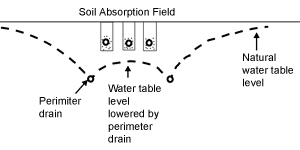
Fig 42. Cross section through a soil absorption field with three parallel lines and a perimeter drain. In Indiana the perimeter drain must be at least 10 feet from the edge of the field and 3 feet below the bottom of the trenches.
Vertical separation distances
The vertical separation distance is the minimum distance between the bottom of a trench or distribution line and a seasonally high water table or a limiting layer. Table 8 lists the distance for several kinds of systems.
Failure of Onsite Systems
Onsite disposal systems are likely to fail if they are installed in unsuitable soils, improperly designed, sloppily constructed, or not regularly maintained. Some systems may fail even if they are properly constructed and maintained because the absorption capacity of the soil may become saturated after long use.
One kind of failure of onsite disposal systems occurs when the soil will not accept effluent, and the entire system backs up. Toilets will not flush and wastewater comes out of the floor drains. This kind of failure is most evident because everyone in the house notices it. It could come about because the soil accepts effluent very slowly, because the system was incorrectly designed, because it was installed when the soil was too wet and the sides of the trench were smeared, because parts of the system were crushed by heavy equipment, or because the septic tank was never pumped and the filter cleaned, which allowed solids to enter the absorption bed and clog soil pores. This failure could also result from the normal build up of a biomat. The small amount of effluent that passes through the system undergoing this kind of failure may or may not be purified.
A second kind of failure occurs when all plumbing fixtures in the house operate satisfactorily, but untreated effluent seeps out on the surface. The causes are similar to the first kind of failure except that effluent somehow gets through the system. It may accumulate in puddles where children play. Or the effluent might flow over the surface to creeks, rivers, or lakes to contaminate surface water. This failure may go unnoticed until someone becomes ill.
A third kind of failure is similar, but groundwater is contaminated. It usually occurs when absorption fields are installed in unsuitable soils. The effluent lines might be too close to the water table for treatment to occur, or the soil may be so porous that the effluent goes through it before it is purified. This kind of failure is most difficult to detect. It is often discovered when bacteria or nitrates are found in well water. By then, the contamination might be very severe and difficult or impossible to correct.
Periodic checks can help homeowners find failed soil absorption fields early. First, they should insist that potential sites are examined by a qualified soil scientist. After a system is operating, puddling or ponding downslope from the field shows that effluent is seeping to the surface before it is fully treated. Especially green grass near the field indicates that effluent is close enough to the surface that grass roots can take up nitrogen from the effluent. Homeowners should also have the outflow from perimeter drains and well water analyzed periodically for bacterial contamination to make sure the purification process in the soil is adequate.
Suitability of Soils for Onsite Disposal
Flood plains and filled depressions are not suitable for any homesite. All onsite disposal practices have already been marked NO for these sites according to a previous rule. Practices have not been marked NO for those depressions not filled with sediment. All depressions, however, are poorly suited for onsite wastewater disposal because they accumulate water from surrounding higher areas, which can over-tax the ability of the soil to absorb wastewater.
Steeply sloping soils are not suitable for onsite systems because effluent is likely to seep out to the surface on the side of the hill. According to some state and federal agencies, they should not be installed on slopes steeper than 15%. Since 15% is not a slope break for soil evaluation, a more conservative 12% is used, so onsite wastewater disposal systems should not be installed where the slope is more than 12%.
back to topSoil Evaluation Rules—Soil Absorption Fields
Sites on flood plains or in a filled depressions have previously been eliminated for consideration as homesites. Soil evaluators consider the factors below to decide if a site is suitable for onsite systems, and if it is, to select the kinds of systems that are suitable.
• Slope. No system is suitable on slopes more than 12%.
• Depth to a limiting layer. The limiting layer may be slowly permeable (fragipan, dense till, and bedrock) and accept effluent very slowly, or it may be very rapidly permeable (coarse sand and gravel) and transmit effluent so fast that it is not purified.
• Depth to seasonally saturated soil horizons. They lack oxygen necessary for aerobic treatment of wastes. This depth is determined from natural drainage class.
• Subsoil texture influences soil permeability and thus size of the soil absorption field.
Soil evaluators consider five systems and mark all suitable ones YES. In practice, usually the least expensive system will be used.
| Mark ALL onsite wastewater disposal practices (scorecard items 58-64) NO if the slope is more than 12%. |
Mark Trench system, ordinary size YES for soils that have all these properties: 1. no limiting layer within 40 inches of the soil surface, |
Mark Trench system, large size YES for soils that have all these properties: 1. no limiting layer within 40 inches of the soil surface, |
Mark At-grade system YES for soils that have all these properties: 1. no limiting layer within 20 inches, |
| Mark Mound system YES for soils that have a slope of 6% or less. |
Mark Drip distribution system YES for soils that have both of these properties: 1. no bedrock limiting layer within 20 inches, and |
Secondary Treatment
Effluent from the septic tank may appear clean, but it still is highly contaminated. Secondary treatment can remove many of these contaminants. The resulting effluent is much cleaner, helping the soil absorption field to have a longer life. Secondary treatment eases the burden on the soil absorption area by lowering the chemical and biological strength of wastewater. It serves as a safety net by filtering out most intestinal pathogens. Typically a biomat forms when septic tank effluent is absorbed by the soil because of the organic materials in the effluent. This biomat greatly reduces the rate at which the soil absorbs effluent, which may cause the system to fail. Effluent that has undergone secondary treatment usually does not form a thick biomat because it contains much less organic matter, which results in a lower BOD level. Three kinds of secondary treatment will be described—sand filters, constructed wetlands, and aeration systems.
Secondary treatment systems require more maintenance than conventional systems because they have pumps, valves, and other mechanical equipment that must be checked and serviced on a regular schedule. Some have live plants that need special care. Ideally, secondary treatment systems should be serviced by professionals. In Indiana, the outflow from secondary treatment must be further treated by the soil rather than discharged onto the soil surface or into surface water such as in a ditch or stream.
Some homeowners use secondary treatment in wooded settings so they can use a drip distribution system instead of clearing an area large enough for a conventional trench soil absorption field. Secondary treatment systems are also used to repair or replace a failed system because effluent that has received secondary treatment may be adequately treated in a smaller soil absorption field. Secondary systems also have potential for general residential use to help improve water quality and to extend the life of the soil absorption field. Generally, however, secondary treatment is used for disposal systems with larger flows, such as campgrounds, clusters of houses, office buildings, schools, and even confined farm animal facilities. This application spreads the cost of the pumps and other equipment and the electricity over a wider base. Check with local agencies before planning one of these systems to make sure they are allowed in your area.
Sand filters
A sand filter is a bed of sand through which septic tank effluent passes in the presence of air and is further purified before going to the soil absorption field. A typical sand filter is shown in Fig. 43. The filter has an impermeable liner, usually made from concrete or plastic. It can be on top of the soil surface, partially buried, or completely buried. It must be properly vented to allow the system to become aerated. At the bottom is an underdrain system made from perforated plastic pipe placed in an aggregate bed (usually gravel). Over the gravel is two to three feet of sand or other filter media. Near the top of the sand are several distribution lines, also made from perforated plastic pipe and placed in gravel. Effluent is pumped from the septic tank periodically in doses. Between the doses of effluent, the bed drains completely and the pores are filled with air, so that the bed is always aerobic (oxygen present). The wastewater treated by the sand filter is then pumped to the soil absorption field.
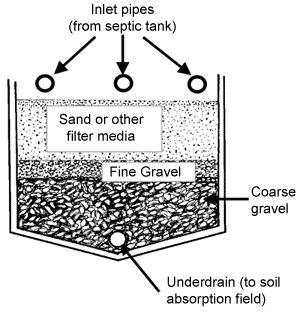
Fig 43. Cross section through an intermittent flow sand filter.
Because the effluent from a sand filter is much cleaner than from a septic tank, a smaller soil absorption field might be needed to purify the effluent if a sand filter is used. This could make a sand filter a wise choice if a system fails and there is little room for a new absorption field. Check with local authorities about regulation of size of fields.
As the wastewater percolates slowly through the filter media, natural physical, biological, and chemical processes combine to purify it. Most treatment occurs in the first 6 to 12 inches of the filter surface. Small particles suspended in the effluent stick to sand grain surfaces or get caught in spaces between grains. In addition, negatively charged grain surfaces can attract positively charged waste particles and bond with them through a process called adsorption.
Sand filters accomplish much of their treatment through biological processes. They are home to a variety of organisms, many of which contribute to treatment by consuming the organic matter in wastewater. Bacteria are the most abundant organisms in the filters, and they do most of the work. There are other organisms, such as protozoa and worms, which also contribute to treatment. After the filter has had a chance to mature—usually after approximately two weeks use—a miniature ecological system develops as the organisms multiply and rely on each other to survive. A small amount of odor is usually produced in a properly functioning sand filter.
The most significant part of the filter ecosystem is a layer called the biomat, which eventually forms near the surface of the filter. This layer contains bacteria, which consume particles in the wastewater. In turn, protozoa feed on the bacteria and help prevent the biomat from becoming so dense that it clogs the filter. This balance between the various life forms and the physical and chemical processes that take place in the sand filter results in extremely efficient wastewater treatment requiring minimal operation and maintenance. The biomat may also contain precipitated iron oxides. Eventually, the biomat can become clogged, and the top layer of sand needs to be raked or removed as part of regular filter maintenance. The biomat can be removed from a sand filter, but it is not possible to remove biomat from a soil absorption field.
There are two main variations in design and function of sand filters, single-pass and recirculating. In the single-pass, or intermittent, sand filter (Fig. 43) effluent passes through the system one time, and most of the nitrogen in the effluent goes to the soil absorption field. Single-pass filters remove about 80% to 90% of the suspended solids and BOD (Table 7), but only about 50% of the nitrogen in the effluent. A single pass sand filter for a three-bedroom house requires about 360 square feet of surface area.
In a recirculating sand filter, most of the effluent that has passed through the sand filter is pumped back to a recirculating tank, and only 15% to 25% of it is pumped to the soil absorption field. Because the effluent passes through the sand filter several times it is cleaner than that from a single-pass system, and less odor is produced. Recirculating systems are as effective in removing BOD and suspended solids as a single-pass systems, but the real treatment benefit is that they remove more nitrogen, as explained in the Soil and Water Chemistry section. A recirculating sand filter requires a surface area of only 90 square feet of surface area, about 1/4 the size of a single pass unit.
Sand filters require periodic maintenance. The pumps must be checked and maintained, and an alarm system is recommended to let the owner know if a pump has failed and water is backing up in the system. The sand surface may need to be raked periodically to break up a mat, or the surface inch or so of sand can be removed and replaced with new sand.
Sand filters are relatively small and can be placed at various locations on a lot, so they have very few limitations for soil evaluation.
Constructed wetlands
A natural wetland uses plants and microbes to purify the water that flows into it. A constructed wetland is built specifically to purify effluent from a septic tank. Natural wetlands usually have water at the surface for at least part of the year. In constructed wetlands, however, the water level is normally maintained below the soil or bed media surface. Effluent from a constructed wetland is further purified in a soil absorption field.
Constructed wetlands are rectangular basins surrounded by banks on all sides. The bottom of the wetland must be impermeable so it can maintain a high water level. The bottom must have a slight slope (0.5%) so water can flow through it by gravity. Effluent enters the cell through a slotted inlet pipe and leaves through an outlet pipe, the level of which controls the water level in the wetland. The cell is filled with a layer of gravel (bed media) 1 to 2 feet thick, and the water level is maintained just below the gravel surface (Fig. 44). Septic effluent flows through the cell one time. It takes two to six days travel time for the effluent to be properly treated.
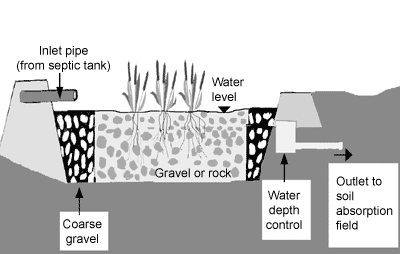
Fig 44. Cross section through a subsurface flow constructed wetland.
Most of the purification is done by microbes that cling to plant roots or to the media. The plants themselves may have structures that transmit oxygen to their roots. Constructed wetlands are usually aerobic in some places and anaerobic in others. The common aquatic species planted are bulrush, reeds, and cattails, but other native plants may seed themselves in a wetland. Plant material may be harvested occasionally to remove nutrients from the system.
Constructed wetlands reduce suspended solids, BOD, and nitrogen levels in the effluent, but their performance is somewhat variable because of changing temperature and other factors. In a climate like Indiana’s, wetlands usually do not freeze if used during the winter, but they must be larger than those in warmer climates because the organisms do not function as well in cold weather. Constructed wetlands are usually used for systems larger than individual homes, such as small communities, motels, campgrounds, and confined livestock facilities. The wetlands should be checked regularly to make sure that they are not bothered by burrowing animals.
Constructed wetlands are built into the ground and must be on nearly level ground so the effluent seeps through them slowly. If bedrock is too shallow, it is difficult to build the system. If the water table is too high, the system might be swamped by natural water. Constructed wetlands have more limitations than sand filters because they are larger and more complex to install. Steep slopes, shallow soils, and high water tables may limit their use.
Aerobic treatment units
Aerobic treatment units are tanks in which air is mixed with septic tank effluent by injection, mixing, or agitation. Bacteria that thrive in oxygen-rich environments break down most of the organics in effluent.
Wastewater is treated in a septic tank before it flows to the aerobic treatment unit, and the effluent from the unit is further processed in a soil absorption field. Aerobic treatment units are sometimes used to replace failed septic tanks. In several states, the effluent is disinfected and then released to surface waters, bypassing soil treatment, but this practice is not acceptable in Indiana.
Aerobic units come in many sizes and shapes—rectangular, conical, etc. They may be either suspended growth units or attached growth units. In suspended growth units, forced air mixes with wastewater in the aeration chamber, and the oxygen supports the growth of aerobic bacteria that digest the solids in the wastewater. The bacteria and solids are suspended in the liquid, unattached to any surface. A typical unit is shown in Fig. 45.
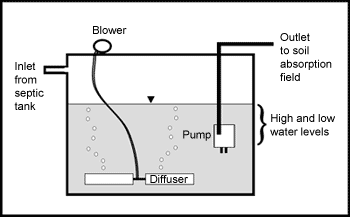
Fig 45. Cross section through an aerobic treatment unit.
In attached growth units, bacteria attach themselves to a solid surface which is exposed alternately to wastewater and air, keeping the system aerobic. This is done either by rotating the surface in and out of the wastewater or by periodically dosing the wastewater onto the surface. These systems are less common than suspended growth systems.
Continuous flow designs allow the wastewater to flow through the unit at the same rate that it leaves the home. Batch process designs use pumps or siphons to control the amount of wastewater in the aeration tank and to discharge the treated wastewater in controlled amounts after a certain period of time. Electric pumps supply air, so the systems have some energy costs. Lower temperatures tend to slow down most biological processes, and higher temperatures tend to speed them up, so cold weather can have adverse effects on the performance of aerobic units.
If they malfunction, aerobic treatment units can release partially treated effluent. This problem can be prevented by using an effluent filter and providing alarms to alert the homeowner of malfunctions. Depending on the design of the system, controls and alarms can be located either inside or outside the home, and alarms can be visible, audible, or both.
Because the effluent from the aerobic unit is much cleaner than from septic tanks, their use can extend the life of a soil absorption system, and in moderately permeable soils, allow for a smaller system. As with other systems, they require periodic maintenance.
back to topSoil Evaluation Rules—Secondary Treatment
In soil evaluation, two secondary treatment systems are considered—sand filters and constructed wetlands. Effluent from secondary systems must go into a soil absorption field, so if a secondary system is to be used, some soil absorption field must be marked YES. Secondary systems are marked YES if they will work. Economics of the system are not considered.
| Mark Sand filter YES if at least one soil absorption field practice is marked YES. |
Mark Constructed wetland YES if all four of the following requirements are met: 1. at least one soil absorption field practices is marked YES, |
Soil and Water Chemistry
This section describes the chemistry of some of the processes mentioned in previous sections. It will help readers with some background in chemistry understand how septic tanks, secondary treatment units and soil absorption fields purify wastewater and how poorly treated wastewater affects water quality.
Eutrophication
Eutrophication is an increase in the production of organic matter in a water body. It is associated with very high concentrations of nutrients, especially nitrogen and phosphorus. Some of this organic matter is produced by higher plants that live in water, such as water lilies and cattails, but most of it is produced by algae, a group of aquatic plants, many of which are microscopic. Two important chemical reactions occur in algae and other green plants—photosynthesis and respiration. Green plants contain chlorophyll which is responsible for photosynthesis, the chemical reaction in which carbon dioxide and water are combined to produce carbohydrates (organic material) and oxygen. Energy from sunlight is used in this reaction. Carbohydrates are the raw materials algae and other plants need to grow.
Photosynthesis

Respiration
is the opposite of photosynthesis. In respiration, plants and microorganisms
use oxygen to “burn” carbohydrates and other
forms of organic matter, converting them back into carbon dioxide and
water. Energy is produced in this reaction. Some of this energy is converted
to heat, which keeps biological treatment systems from freezing
in the winter.
Respiration

Algae are the dominant plants in eutrophic waters. In algae, photosynthesis dominates during the day, and respiration dominates at night, but overall, photosynthesis must dominate if the algae are to grow, so one might expect that there would be a net increase in the oxygen content of the water. Since algae live on or near the water surface, however, much of the oxygen they produce diffuses into the air rather than into the water. But after algae die, they sink to the bottom of the lake where they are decomposed by microorganisms. The microbes use oxygen to convert carbohydrates back into carbon dioxide and water. Eventually the O2 supply is depleted. Also, algae may grow so thick on the water surface that they block light from other plants living in the water. These plants then die and more oxygen is consumed as they decompose. Soon all the oxygen is gone from the nutrient-rich lake and almost everything living in it dies, including fish.
Nitrogen
Nitrogen (N) undergoes many chemical processes in soils that are very important for plant growth and crop production as well as for wastewater disposal. Many of these processes involve chemical oxidation or reduction. In the nitrification process, ammonium-N (NH4+) is oxidized to nitrate-N (NO3-) in several steps by microorganisms in the presence of oxygen. In this series of reactions, N sequentially loses electrons (negative charges), but not protons (+ charges) so its valence state increases:
Nitrification

In denitrification, nitrate-N is reduced to dinitrogen gas (N2), or other gases, by microorganisms in the absence of oxygen:
Denitrification

Plants can take up both ammonium and nitrate. Trees use mainly ammonium and farm crops use mainly nitrate. Ammonium is more tightly held by soils because it has a positive charge and is attracted to negative charges on soil clay and organic matter. For farm crops, most fertilizer N is applied as ammonia (NH3), which is readily converted to ammonium in the soil. If the soil is not waterlogged, ammonium is converted to nitrate by nitrification.
Septic tanks are anaerobic (lack oxygen), and ammonium (NH4+) is formed in them. It moves with the effluent to the soil absorption field or a sand filter which are aerobic (contain oxygen). There, most of the ammonium is oxidized to nitrate (NO3-) by the nitrification process.
Nitrate in farm fields or soil absorption fields is highly soluble. It moves with the water in the soil because it is not held by negative charges on soil particles and ends up in surface water or groundwater. Septic tank effluent contains almost as much N as raw sewage (Table 7), which shows that little N is lost during the treatment process. If there is a high density of home systems, or a combination of home systems and farm manure systems, the nitrate content of drinking water could exceed the allowable nitrate limit. This might also happen after a year of low corn yield. Before or during the growing season, farmers apply somewhat more N fertilizer than they expect the crop to take up that year. If the corn yield is especially low, the crop will take up less N than expected, and the soil will contain more nitrate than usual. The excess nitrate can then move to the groundwater or to surface water bodies. Farmers try to prevent N from leaving their fields. One method is to grow cover crops that take up N in late summer and fall. These crops hold the N during the leaching season of late winter and spring. The crops are then killed with herbicides in late spring, and the N in the cover crop is released for use by the next regular crop. Another method of holding N in soils, especially wet ones, is to apply chemicals that inhibit denitrification and keep N in the ammonium form, which is tightly held by the soil.
The environment sequence in a septic tank and soil absorption field system is anaerobic and then aerobic. This could lead to high nitrate levels in the soil. If the goal is to reduce the N content of the effluent, however, the environment sequence must be reversed, aerobic then anaerobic. In this sequence, N is first converted to nitrate, and then nitrate is reduced to dinitrogen gas (N2) in the denitrification process. This gas then goes off into the air. To achieve the aerobic-anaerobic sequence, most of the effluent from the aerobic sand filter is pumped back to the anaerobic septic tank or recirculating tank in which the denitrification process produces N2. The gas then moves from the tank into the air. Some of the effluent from the sand filter flows to the soil absorption field. Since this effluent has passed through the sand filter several times, most of it has undergone denitrification, so it contains few impurities (Table 7).
Experiments are also being done to reduce the nitrate content of soils used for crop production in a process similar to using a recirculating sand filter for wastewater. During the summer, nitrates are abundant in the soil like they are in the sand filter. Drainage tile lines are closed in the fall. In late winter and early spring, nitrates leach to the subsoil, which becomes saturated and anaerobic. There, N2 gas is produced and lost to the air, like it is in a recirculating tank or septic tank. Field tile are opened in the spring so the soil can drain and be suitable for farm operations.
Under some conditions, the denitrification process does not go all the way to N2. Instead, N2O, a potent greenhouse gas, is released to the atmosphere, which could contribute to global climate change. N2O may also be produced in the nitrification process. This process is being studied.
Iron
In soil and water, iron occurs in two forms, ferrous (Fe2+) and ferric (Fe3+). In the process of reduction, Fe3+ gains an electron to become Fe2+, and in the process of oxidation, Fe2+ loses an electron to become Fe3+. A memory aid is oil rig—oxidation is loss and reduction is gain in electrons. In primary minerals, the original minerals on the earth’s crust, Fe is mainly in the Fe2+ form. When these minerals weather in a soil that is not waterlogged, Fe oxidizes to Fe3+ and precipitates as an iron oxide. These oxides are responsible for the reddish and brownish colors of soils. Microbes are always active in soils, and they produce electrons in their respiration processes. When the soil is moist but not saturated with water, oxygen accepts the electrons, and carbon dioxide is produced. When soils become saturated with water, however, oxygen is not available to the microbes, so the electrons they produce are given to other substances. One of these electron acceptors is Fe3+. When Fe3+ in an iron oxide accepts an electron, it is converted to Fe2+ (reduced), the iron oxide dissolves, and Fe2+ goes into solution. Because the iron oxide dissolves, the brownish color disappears, and we see the grayish color of other soil minerals such as silicate clays. Thus, the more poorly drained a soil, the grayer is its subsoil. The Fe2+ moves with the soil solution and eventually gets into well water. In the home water system, it stays in solution until it comes in contact with oxygen, and then it precipitates again as a brownish iron oxide. This might occur in a sink with a dripping faucet, a toilet tank or bowl, or in a shower. All Fe in household water, and some that is added from foods, etc., ends up in wastewater. In the septic tank, it becomes or remains reduced (Fe2+) and in solution. In an oxidizing system, Fe3+ again precipitates. This could be in a soil absorption field, a sand filter, or an aerobic treatment unit. If enough iron oxide precipitates, it could clog the pores in the filter or the soil. An advantage of a sand filter is that if a crust of iron oxide forms, it can be broken up by mixing or raking the crust, or the iron-encrusted sand can be replaced with clean sand.
Phosphorus
All the onsite waste disposal systems discussed here remove very little phosphorus (P) from the wastewater, but little is known about the fate of P. Phosphate, the common form of P, reacts readily with many calcium, iron, and aluminum compounds or ions, which are plentiful in soils, so P is probably adsorbed by the soil. After long-term use, however, the soil could become saturated with P, and then transmit it to surface water or groundwater. It is also possible that organic forms of P are created in the septic tank, and these forms might be mobile in soils.
Traditionally, we believed that P moved very little in farm soils because it is so tightly held by iron, aluminum, and calcium compounds. With very high applications of P in farm manure from confined feeding operations, however, we are observing that P can move in soils and can get into water supplies. Also much P is lost from fields with eroded sediment. This P can end up in lakes and contribute greatly to eutrophication.
Septic System Care
Septic systems are very much like automobiles. They need periodic inspections and proper maintenance to continue working properly. Also, like automobiles, they must be operated properly and cannot be overtaxed without the owner suffering consequences such as repair or replacement bills.
Septic tank
The septic tank traps the solids in the wastewater and should be checked every year or two. The inspection port should be opened and the baffles (internal slabs or tees) should be checked to ensure that they are still in good condition (Fig. 35). If you have a septic tank effluent filter, it should also be inspected. Effluent filters require periodic cleaning. Some filters are equipped with alarm systems to alert the homeowner when the filter has clogged and needs to be cleaned. Failure to keep the filter open results in a backup of wastewater in the home. Septic systems that have mechanical parts such as pumps should also be inspected at least once a year or as recommended by the manufacturer.
A properly designed septic system should have a septic tank with sufficient volume to accumulate solids for several years. As the level of solids rises in the tank, the wastewater has less time to settle properly and suspended solid particles overflow into the absorption field. If the tank is not periodically pumped, these solids eventually clog the absorption field to the point where a new field will be needed.
Commercial septic tank additives do not eliminate the need for periodic pumping and actually may be harmful to the absorption field. When the septic tank is pumped, be sure that it is completely emptied and that all the sludge and scum are removed. It is not necessary to retain any of the solids to restart the digestive process, nor should you wash or disinfect the tank after having it pumped.
When to have your septic tank pumped
A specific determination of when it’s time to pump out the septic tank can be made by periodically checking the depth of solids and level of scum buildup on top of the wastewater in the tank. Two factors affect how often you should have your septic tank pumped. The first factor is the size or capacity of the tank itself. The more people using a system and the smaller the tank, the faster the solids will accumulate, and the more frequently the tank will need to be pumped. Also, the surge of water from large hot tubs and whirlpool baths can wash solids out of the tank and into the absorption field. An inspection can determine whether the system is of adequate capacity to handle the volume of solids and flow from the number of people in the household and types of appliances used. A larger capacity system provides better treatment and requires less pumping.
The second factor is the volume of solids in the wastewater. If you have a garbage disposal, for example, you will have to pump out your system more frequently than if food wastes are disposed of in other ways. The use of a garbage disposal may increase the amount of solids in the septic tank by as much as 50%. Excessively soiled clothes may add solids to your septic tank. Sometimes, geographical location may also contribute to extra solids ending up in the septic tank. For example, systems in coastal areas may have an accumulation of sand in the septic tank from washing beach clothes. Usually, the tank should be pumped out and inspected every three to five years.
Reducing the flow of wastewater
Water conservation devices such as low-flow toilets or shower fixtures can greatly reduce the amount of wastewater and prolong the life of your septic system. For example, up to 53 gallons of water are discharged into your system with each load of laundry. If several loads are done in one day, it can put considerable stress on your system. A better practice would be to space your laundry washing throughout the week, or replace the clothes washer with a modern front-loading water conservation unit.
The new ultra low-flush toilets use between 1 and 1.6 gallons of water per flush and provide much less flow than the older 5 or 6 gallon models. Low-flow faucet aerators on sink faucets and low-flow showerheads save additional water.
Soil absorption field
Soil absorption fields should be checked for sogginess or ponding which indicates improper drainage, a clogged system, or excessive water use. Excessively green strips suggest that effluent is rising to the surface where plant roots take up nitrogen, which makes plants green. To protect and prolong the life of the absorption field:
• Plant only grass over and near your septic system. Roots from nearby trees or shrubs may clog and damage the absorption field.
• Keep construction equipment off and do not drive or park over any part of your septic system. This can compact the soil and reduce absorption. Surface compaction can also prevent air from moving to the absorption system. Air is needed to keep the system aerobic. Furthermore, components of the system can be crushed.
• Direct all wastewater from your home into the septic tank. This includes all sink, bath, shower, toilet, washing machine, and dishwasher wastewater. Any of this wastewater can contain disease-causing microorganisms or environmental pollutants.
• Keep roof drains, basement sump pump drains, and other rainwater or surface water drainage systems away from the absorption field. Flooding of the absorption field with excessive water will keep the soil from naturally cleansing the wastewater, which can lead to groundwater and/or nearby surface water pollution.
Septic System Health Tips
What you put into your septic system will have a direct effect on whether or not you have a healthy, long-lasting and trouble-free system. Your septic system is not a dispose-all. These tips will help keep it in good condition.
• Repair any leaky faucets or toilets and use low-flow fixtures.
• Do not use caustic drain openers for a clogged drain. Instead, use boiling water or a drain snake to open clogs.
• Do not use septic tank additives, commercial septic tank cleansers, yeast, sugar, etc. These products are not necessary and some may be harmful to your system.
• Use commercial bathroom cleaners and laundry detergents in moderation.
• Avoid garbage disposal units.
• Sodium ions in salt may cause clay in the soil absorption field to become dispersed and decrease the soil infiltration rate. The backwash from regenerating a water softener is very high in salt (NaCl). Check with your county health department about the best way to dispose of water softener backwash.
• Do not put disposable diapers, sanitary napkins, tampons, paper towels, facial tissues, plastics, cat litter, or cigarettes into your septic system. These items quickly fill your septic tank with solids, decrease the efficiency, and will require that you pump out the septic tank more frequently. They may also clog the sewer line to the septic system causing wastewater to back up into your home.
• Avoid dumping grease or fats down your kitchen drain. They solidify and may contribute to blockages in the system.
• Keep latex paint, varnishes, thinners, waste oil, photographic solutions, pesticides, or other hazardous chemicals out of your system. Even in small amounts, these items can destroy the biological digestion taking place within your septic system.
Septic systems are a simple way to treat household wastewater and are easy to operate and maintain. More homeowners need to take an active role in maintaining septic systems. Once they learn how their systems work, it is easier for them to appreciate the importance of a few sound operation and maintenance practices.
back to top